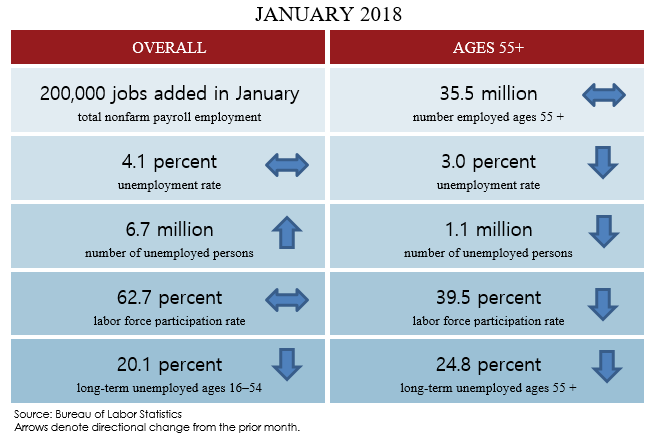AARP Hearing Center
Several employment indicators for those ages 55+ improve in January
By Jennifer Schramm, February 2, 2018 05:04 PM

Employment Overview
According to the Bureau of Labor Statistics (BLS) January Employment Situation Summary, the unemployment rate for persons 55 and older decreased from 3.3 percent in December to 3.0 percent in January. The number of unemployed persons ages 55+ also decreased to 1.1 million, down from 1.2 million in December. The percentage of 55+ jobseekers considered long-term unemployed (those job searching for 27 weeks or more) declined from 30.6 percent in December to 24.8 percent in January. Overall the economy added 200,000 jobs in the first month of 2018, representing an increase from the 160,000 jobs (revised up from 148,000) added in December 2017. The overall unemployment rate (4.1 percent) and labor force participation rate (62.7 percent) both remained unchanged from December.
Spotlight on Occupations of the 65+
An analysis of government data on occupational distributions by age found the share of workers ages 65+ decreased in occupations with middle-range wages and salaries compared with workers ages 45 to 65. However, they increased for those ages 65+ compared with the 45 to 65 age group in occupations with both relatively high or relatively low wages and salaries.
Why might workers ages 65 and older represent a comparatively larger share of both high and low wage occupations? Possible reasons involve working conditions, finances, education, and skills. These factors could influence the share of workers ages 65+ in high and low wage occupations in different ways.
Occupations requiring low levels of education typically pay lower wages. Individuals in these occupations are more likely to be driven by financial necessity to work past traditional retirement age. Their lower incomes make it more difficult to save for retirement and they often do not have access to employer-provided retirement plans. The research found that the occupation with the greatest difference (both absolute and relative) in the share of workers from the two age groups was the food preparation and serving related group. These occupations are usually low paying, are often part-time and, in the 65+ age group, employ mostly women, who are less likely to have adequate retirement savings compared with men.
Higher-wage occupations, meanwhile, often require higher levels of education. Those occupations are in turn associated with longer career lifespans due to better opportunities and working conditions. Other occupational research has found that opportunities for older workers improved significantly between the late 1990s and the early part of this decade, however gains mainly went to better-educated older workers. The greater prospects for the highly educated to work beyond traditional retirement age, as well as higher wages and good working conditions that act as incentives to stay on the job, may be driving the increase in the share of workers ages 65+ in high wage occupation groups.
More details on the latest employment data are found in the January Employment Data Digest, PPI’s monthly review of job trends for those ages 55 and over.
































































